Degradation Characteristics and Mechanisms of Steel Fiber-Reinforced Concrete Linings in Subsea Tunnels: Insights from Accelerated Erosion Tests with Applied Electric Fields
Abstract
1. Introduction
2. Experimental Program
2.1. Materials and Mix Design
2.2. SFRC Specimen Preparation
2.3. Accelerated Corrosion Scheme Using an External Electric Field
2.4. X-Ray CT Test
2.5. Chloride Ion Concentration and Steel Corrosion Rate Testing
3. Results and Discussion
3.1. Distribution Characteristics and Evolutionary Patterns of Surface Rust Expansion Cracks
3.2. Non-Uniform Corrosion Patterns of Reinforcing Bars and Steel Fibers
3.3. Characteristics and Evolution of Pore Structure
3.4. Internal Crack Distribution Characteristics and Development Pattern
3.5. Distribution Characteristics of Chloride Ion Concentration and Steel Corrosion Rate
4. Conclusions
- (1)
- The degradation process of the specimens is closely related to the steel fiber content. The specimens without steel fibers exhibit a high level of crack connectivity, and the corrosion products are concentrated. The addition of steel fibers can delay crack formation; however, an excessively high fiber content may intensify the localized accumulation of corrosion products. Specimens without steel fibers are more prone to forming penetrating cracks, facilitating the rapid diffusion of corrosive media. The incorporation of steel fibers alters the crack initiation and propagation patterns, resulting in a more dispersed crack distribution. Therefore, optimizing the steel fiber content requires balancing the crack resistance and corrosion resistance;
- (2)
- The accelerated corrosion method using an external electric field successfully simulates the non-uniform corrosion process of the reinforcement in SFRC linings in undersea tunnels in natural conditions. Due to the ingress of chloride ions on one side, corrosion products accumulated only on the surface of the chloride-infiltrated side. This method effectively demonstrates the chloride corrosion path and its impact on reinforcement corrosion, providing valuable insights for anti-corrosion design in practical engineering. Furthermore, the corrosion of hooked-end steel fibers predominantly occurs at the hooked ends;
- (3)
- As the accelerated corrosion duration increases, the proportion of large pores in SFRC increases from 28.17% to 40.03%, while the proportion of medium-size pores (10–100 mm3) decreases. As a result of the accelerated corrosion induced by the external electric field, some medium-sized pores connect with other pores and gradually expand into large-sized pores;
- (4)
- In ordinary reinforced concrete specimens without steel fibers, the main crack penetrates the protective layer. Secondary cracks appear around the steel bars, but do not reach the surface. In contrast, after 56 h of degradation of SFRC specimens, no through-cracks are formed. Instead, short cracks (6–25 mm) appear only at the edges, demonstrating the effective crack-bridging role of steel fibers. Future research should focus on comparing the similarities and differences between deterioration cracks and structural cracks;
- (5)
- Concrete specimens without steel fibers exhibited the deepest chloride ion penetration and the poorest resistance to corrosion. The incorporation of steel fibers effectively enhanced the resistance of concrete to chloride ion ingress. The corrosion rate of the steel reinforcement was influenced by the applied electric field, the pore structure of the concrete, and the steel fiber content. An appropriate amount of steel fiber improved the concrete structure, reduced chloride ion permeability, and enhanced the corrosion resistance of the steel reinforcement, thereby delaying the corrosion process.
Author Contributions
Funding
Data Availability Statement
Conflicts of Interest
References
- Manquehual, C.J.; Jakobsen, P.D.; Holter, K.G.; De Weerdt, K.; Danner, T.; Bruland, A. Comparison of the condition of steel fiber-reinforced shotcrete with water-glass and alkali-free activators after more than 20 years of service in a subsea road tunnel. Constr. Build. Mater. 2022, 328, 127090. [Google Scholar] [CrossRef]
- Ju, X.L.; Wu, L.J.; Liu, M.W.; Jiang, H.; Zhang, W.X. Modelling of Chloride Concentration Profiles in Concrete by the Consideration of Concrete Material Factors under Marine Tidal Environment. J. Mar. Sci. Eng. 2022, 10, 26. [Google Scholar] [CrossRef]
- Sun, Z.Y.; Zhang, D.L.; Fang, Q. Technologies for large cross-section subsea tunnel construction using drilling and blasting method. Tunn. Undergr. Space Technol. 2023, 141, 105161. [Google Scholar] [CrossRef]
- Gong, H.M.; Xue, Y.G.; Fu, K.; Kong, F.M.; Han, M.; Zhou, B.H.; Guo, Y.B. Assessing and predicting surrounding rock settlement troughs in the subsea tunnel: A case study of Haicang Tunnel. Mar. Georesources Geotechnol. 2024, 1–12. [Google Scholar] [CrossRef]
- Li, P.F.; Wang, F.; Long, Y.Y.; Zhao, X. Investigation of steady water inflow into a subsea grouted tunnel. Tunn. Undergr. Space Technol. 2018, 80, 92–102. [Google Scholar] [CrossRef]
- Sun, Z.Y.; Zhang, D.L.; Fang, Q. Determination Method of Reasonable Reinforcement Parameters for Subsea Tunnels Considering Ground Reinforcement and Seepage Effect. Appl. Sci. 2019, 9, 21. [Google Scholar] [CrossRef]
- He, Z.S.; He, C.; Kang, X.Y.; Huang, X.; Wang, S.M. Assessment of structural performance of super large cross-section subsea RC shield tunnels: Emphasis on the combined effects of highly hydrostatic pressure and corrosion-induced deterioration. Ocean Eng. 2023, 288, 15. [Google Scholar]
- Horny, U.; Bayer, L.; Schiesser, K.; Kliem, O. Metro Doha Green Line: Fibre reinforced tunnel linings—Design and construction experience. Geomech. Tunn. 2021, 14, 347–355. [Google Scholar]
- Manquehual, C.J.; Jakobsen, P.D.; Holter, K.G.; De Weerdt, K.; Bruland, A. Investigation of leaching in steel fiber-reinforced shotcrete exposed to fresh and saline groundwater in a subsea road tunnel. Cem. Concr. Res. 2023, 163, 21. [Google Scholar] [CrossRef]
- Frazao, C.; Camoes, A.; Barros, J.; Gonçalves, D. Durability of steel fiber reinforced self-compacting concrete. Constr. Build. Mater. 2015, 80, 155–166. [Google Scholar] [CrossRef]
- Gong, C.J.; Kang, L.; Zhou, W.H.; Liu, L.H.; Lei, M.F. Tensile Performance Test Research of Hybrid Steel Fiber-Reinforced Self-Compacting Concrete. Materials 2023, 16, 15. [Google Scholar] [CrossRef] [PubMed]
- Zhang, S.; Wang, J.; Lin, G.; Yu, T.; Fernando, D. Stress-strain models for ultra-high performance concrete (UHPC) and ultra-high performance fiber-reinforced concrete (UHPFRC) under triaxial compression. Constr. Build. Mater. 2023, 370, 15. [Google Scholar] [CrossRef]
- Salvador, R.P.; Serafini, R.; Rambo, D.A.S.; Sant’Anna, A.S.; Quarcioni, V.A.; Figueiredo, A.D. Effect of external sulfate attack on the tensile properties of fiber-reinforced sprayed concrete. Mag. Concr. Res. 2024, 76, 872–881. [Google Scholar] [CrossRef]
- Chanvillard, G.; PierreClaude, A. Pull out behavior of corrugated steel fibers—Qualitative and statistical analysis. Adv. Cem. Based Mater. 1996, 4, 28–41. [Google Scholar] [CrossRef]
- Wang, Y.; Niu, D.T.; Miao, Y.Y. Influence of steel fibre on micropore structure of concrete. Mater. Res. Innov. 2015, 19, 1135–1139. [Google Scholar] [CrossRef]
- Hwang, J.P.; Jung, M.S.; Kim, M.; Ann, K.Y. Corrosion risk of steel fibre in concrete. Constr. Build. Mater. 2015, 101, 239–245. [Google Scholar] [CrossRef]
- Chen, Y.J.; Liu, M.Y.; Wang, L.N.; Zhou, Z.Q.; Li, H.L. Water inflow prediction and waterproof-drainage system optimization in undersea tunnel. Mar. Georesources Geotechnol. 2025, 43, 101–111. [Google Scholar] [CrossRef]
- Song, Q.; Xue, Y.G.; Li, G.K.; Su, M.X.; Qiu, D.H.; Kong, F.M.; Zhou, B.H. Using Bayesian network and Intuitionistic fuzzy Analytic Hierarchy Process to assess the risk of water inrush from fault in subsea tunnel. Geomech. Eng. 2021, 27, 605–614. [Google Scholar]
- Shi, Y.; Lei, M.; Qin, M.; Sun, N.; Liu, L.; Zhao, C.; Jia, C. A non-linear chloride convection-diffusion model and solution method for undersea tunnel lining concrete considering unsaturated effect. J. Cent. South Univ. Sci. Technol. 2024, 55, 1035–1045. [Google Scholar]
- Mangat, P.S.; Gurusamy, K. Chloride Diffusion in Steel Fiber Reinforced Marine Concrete. Cem. Concr. Res. 1987, 17, 385–396. [Google Scholar] [CrossRef]
- Song, Z.P.; Li, S.H.; Brouwers, H.J.H.; Yu, Q.L. Corrosion risk and corrosion-induced deterioration of ultra-high performance fiber-reinforced concrete containing initial micro-defects. Cem. Concr. Compos. 2023, 142, 105208. [Google Scholar]
- Feng, K.; Yang, R.J.; Geng, J.Y.; Cao, X.P.; He, C.A.; Yang, W.Q.; Zhang, H.H. Experimental investigation of mechanical-performance deterioration of HFRC segment under combined effect of sustained loading and chloride-induced corrosion. Tunn. Undergr. Space Technol. 2021, 114, 14. [Google Scholar]
- Gao, D.Y.; Zhang, L.J.; Zhao, J.; You, P.B. Durability of steel fibre-reinforced recycled coarse aggregate concrete. Constr. Build. Mater. 2020, 232, 11. [Google Scholar] [CrossRef]
- Chen, G.; Hadi, M.N.S.; Gao, D.Y.; Zhao, L.P. Experimental study on the properties of corroded steel fibres. Constr. Build. Mater. 2015, 79, 165–172. [Google Scholar]
- Kim, B.; Boyd, A.J.; Lee, J.Y. Durability performance of fiber-reinforced concrete in severe environments. J. Compos Mater. 2011, 45, 2379–2389. [Google Scholar]
- Michel, A.; Solgaard, A.O.S.; Pease, B.J.; Geiker, M.R.; Stang, H.; Olesen, J.F. Experimental investigation of the relation between damage at the concrete-steel interface and initiation of reinforcement corrosion in plain and fibre reinforced concrete. Corros. Sci. 2013, 77, 308–321. [Google Scholar]
- Feng, W.P.; Tarakbay, A.; Memon, S.A.; Tang, W.C.; Cui, H.Z. Methods of accelerating chloride-induced corrosion in steel-reinforced concrete: A comparative review. Constr. Build. Mater. 2021, 289, 14. [Google Scholar]
- Xiaoming, Y.; Yonglin, C.; Tianyu, W. Relationship of corrosion of concrete reinforcement to accelerated corrosion current. Proc. Inst. Civ. Eng. Constr. Mater. 2019, 172, 263–268. [Google Scholar]
- He, Z.S.; He, C.; Ma, G.Y.; Wang, S.M.; Huang, X. Experimental investigation on the deterioration process and spatial variation of corrosion damage of RC segmental specimens under sustained load. Constr. Build. Mater. 2022, 349, 16. [Google Scholar]
- Peng-Fei, L.; Yan, M.; Jin-Quan, Z.; Zi-Wei, S. Non-Uniform Corrosion Expansion and Bond Analysis of RC Members. In Proceedings of the 2021 7th International Conference on Hydraulic and Civil Engineering & Smart Water Conservancy and Intelligent Disaster Reduction Forum (ICHCE & SWIDR), Nanjing, China, 6–8 November 2021; pp. 587–593. [Google Scholar]
- Zhang, L.; Niu, D.T.; Wen, B.; Luo, D.M. Concrete Protective Layer Cracking Caused by Non-Uniform Corrosion of Reinforcements. Materials 2019, 12, 4245. [Google Scholar] [CrossRef]
- Jin, N.G.; He, J.H.; Fu, C.Q.; Jin, X.Y. Study on experimental method and morphology of accelerated non-uniform corrosion of steel bars. J. Zhejiang Univ. Eng. Sci. 2020, 54, 483–490. [Google Scholar]
- Fu, C.Q.; Jin, N.G.; Ye, H.L.; Liu, J.M.; Jin, X.Y. Non-uniform corrosion of steel in mortar induced by impressed current method: An experimental and numerical investigation. Constr. Build. Mater. 2018, 183, 429–438. [Google Scholar] [CrossRef]
- Li, Q.; Gao, Z.J.; Yang, T.; Dong, Z.; Jiang, Z.L.; He, Q.; Fu, C.Q. Rust Distribution of Non-Uniform Steel Corrosion Induced by Impressed Current Method. Materials 2022, 15, 23. [Google Scholar] [CrossRef] [PubMed]
- Tang, L. Electrically accelerated methods for determining chloride diffusivity in concrete—Current development. Mag. Concr. Res. 1996, 48, 173–179. [Google Scholar] [CrossRef]
- Tang, L.P.; Nilsson, L.O. Rapid-Determination of The Chloride Diffusivity in Concrete by Applying an Electrical-Field. ACI Mater. J. 1992, 89, 49–53. [Google Scholar]
- Shi, J.J.; Ming, J.; Sun, W. Accelerated Corrosion Behavior of Steel in Concrete Subjected to Sustained Flexural Loading Using Electrochemical Methods and X-Ray Computed Tomography. J. Mater. Civ. Eng. 2018, 30, 04018131. [Google Scholar] [CrossRef]
- Wang, X.X.; Jin, Z.Q.; Liu, J.P.; Chen, F.X.; Feng, P.; Tang, J.H. Research on internal monitoring of reinforced concrete under accelerated corrosion, using XCT and DIC technology. Constr. Build. Mater. 2021, 266, 14. [Google Scholar] [CrossRef]
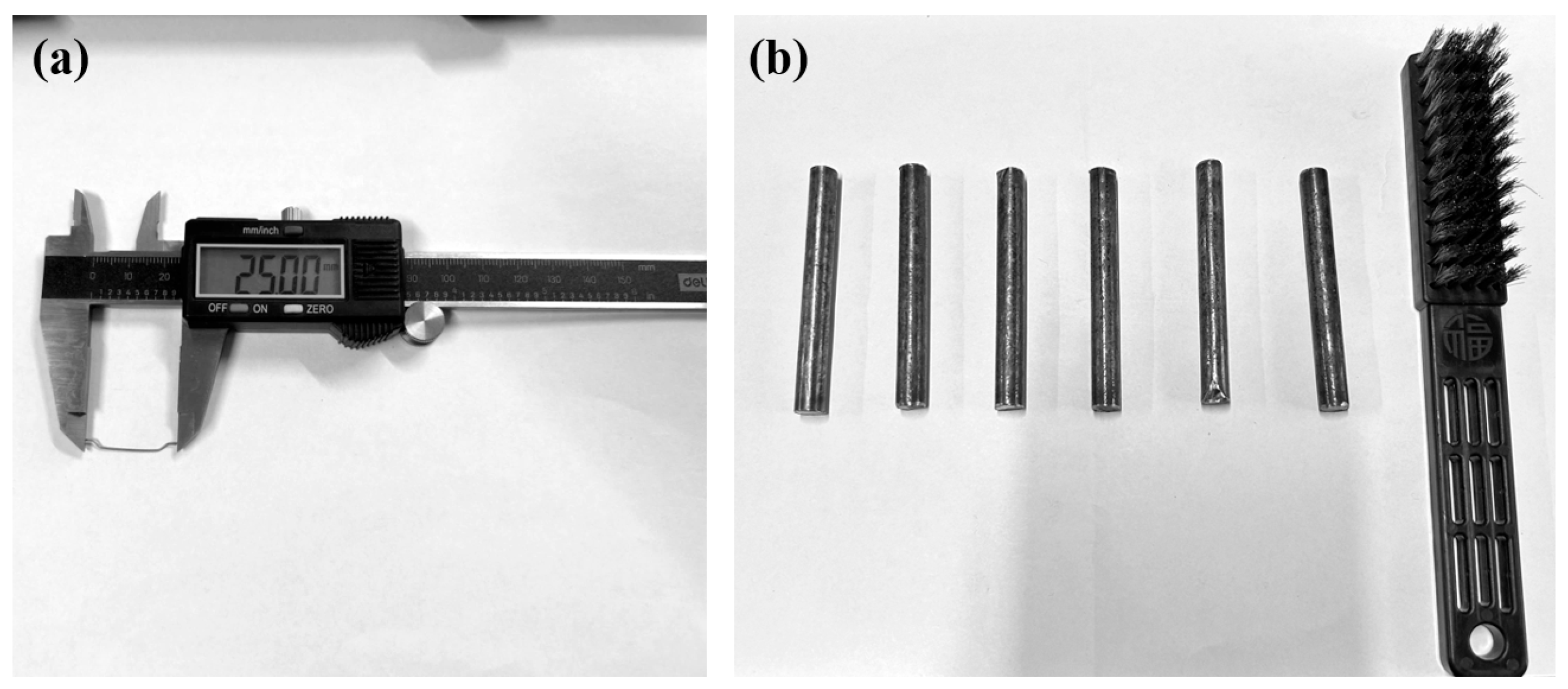



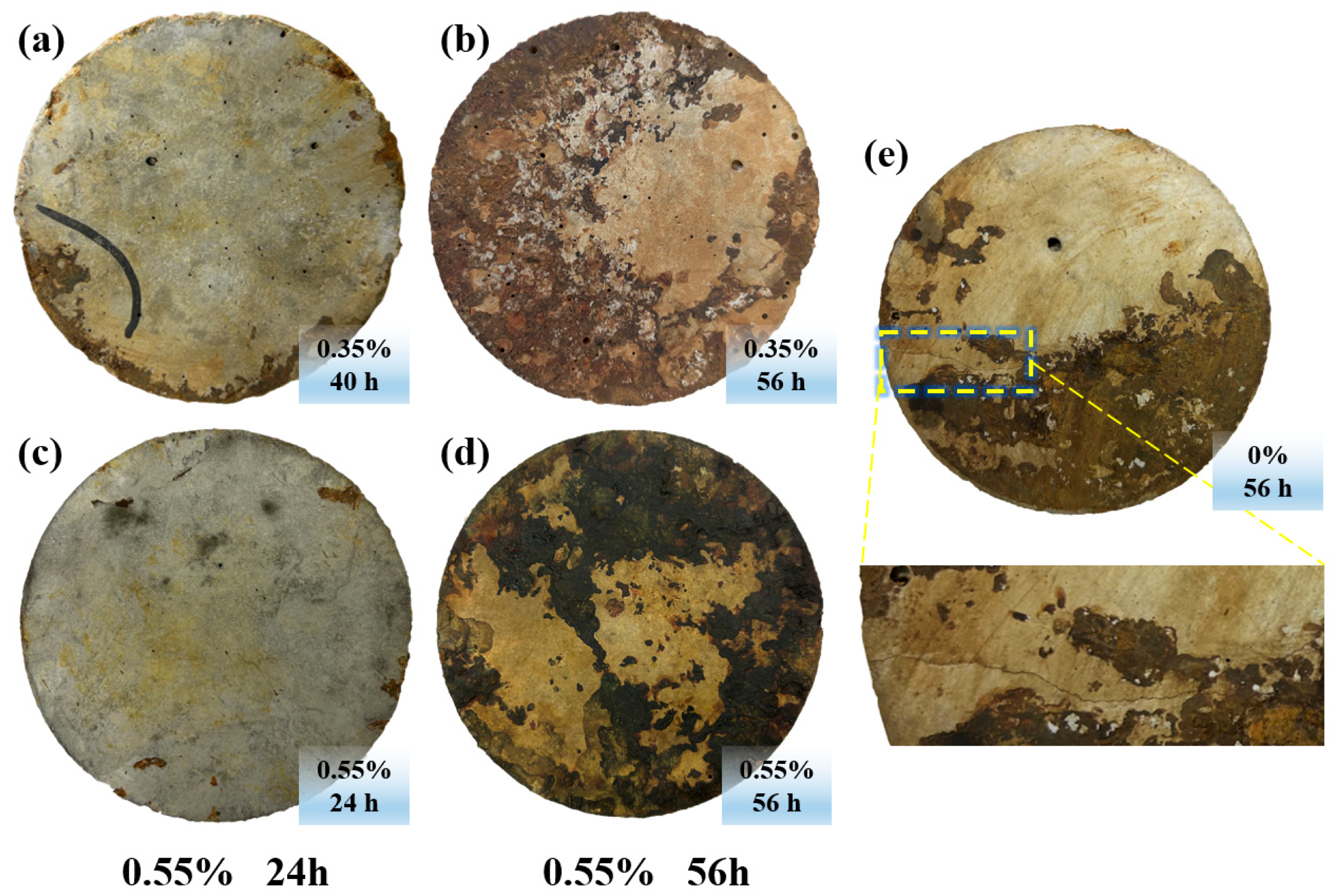
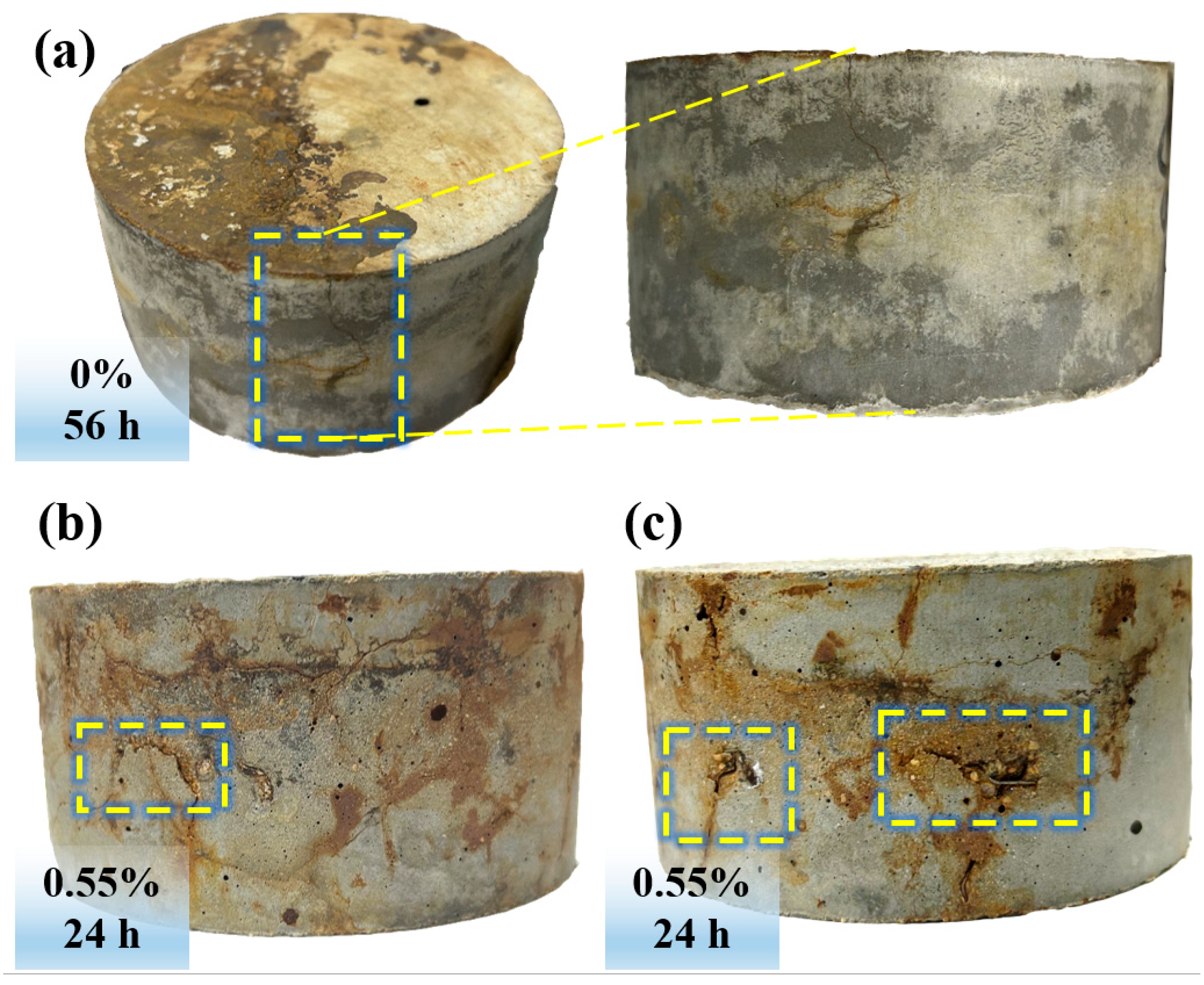
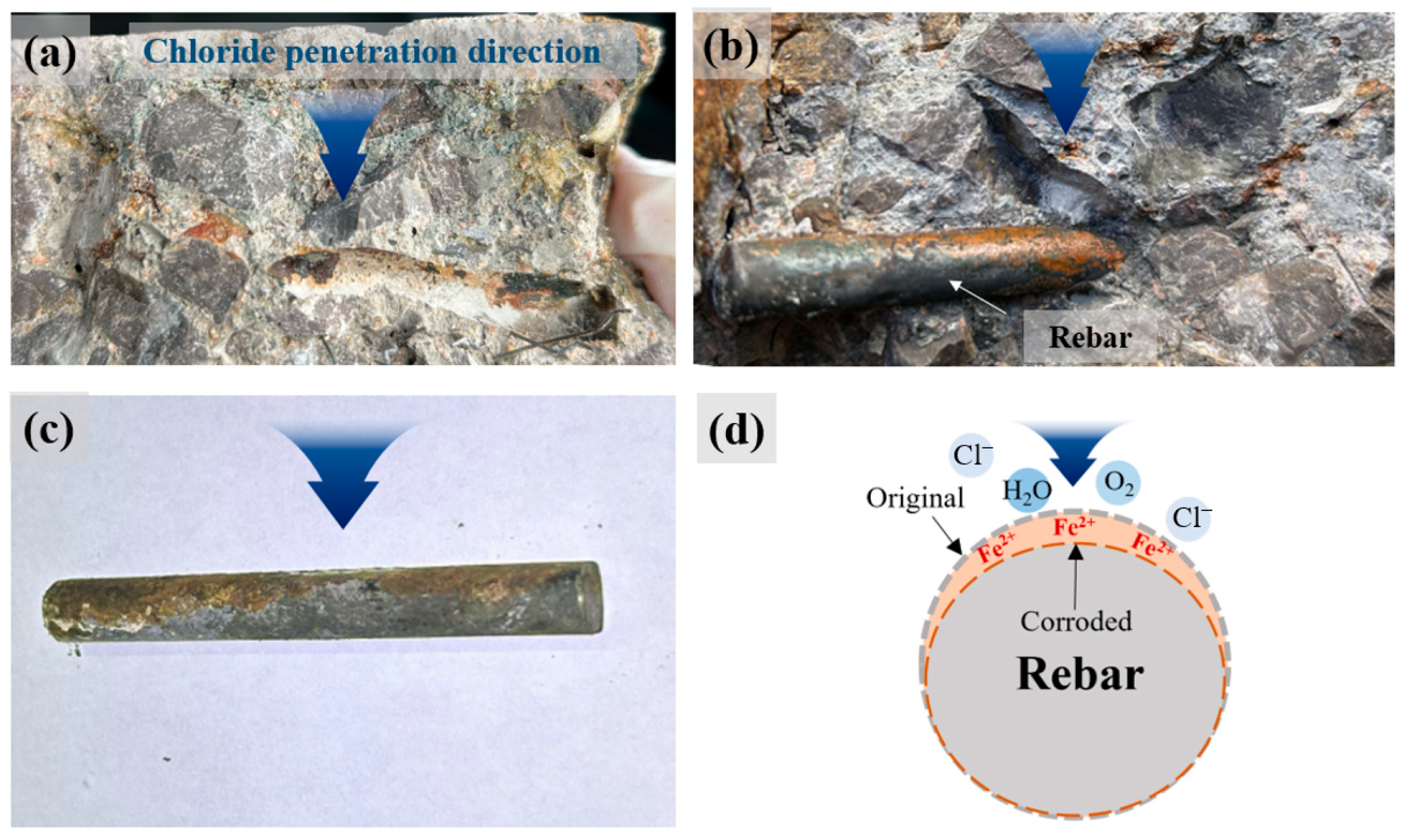

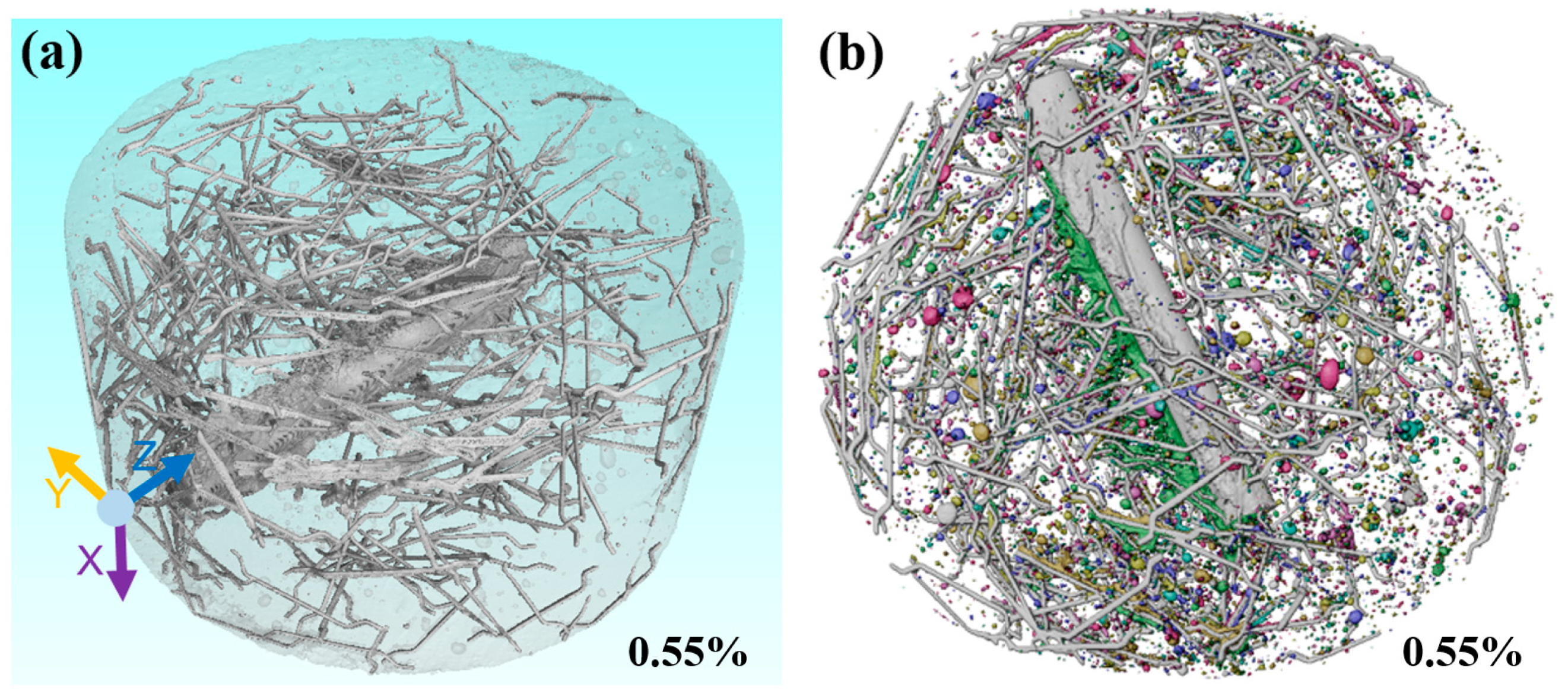
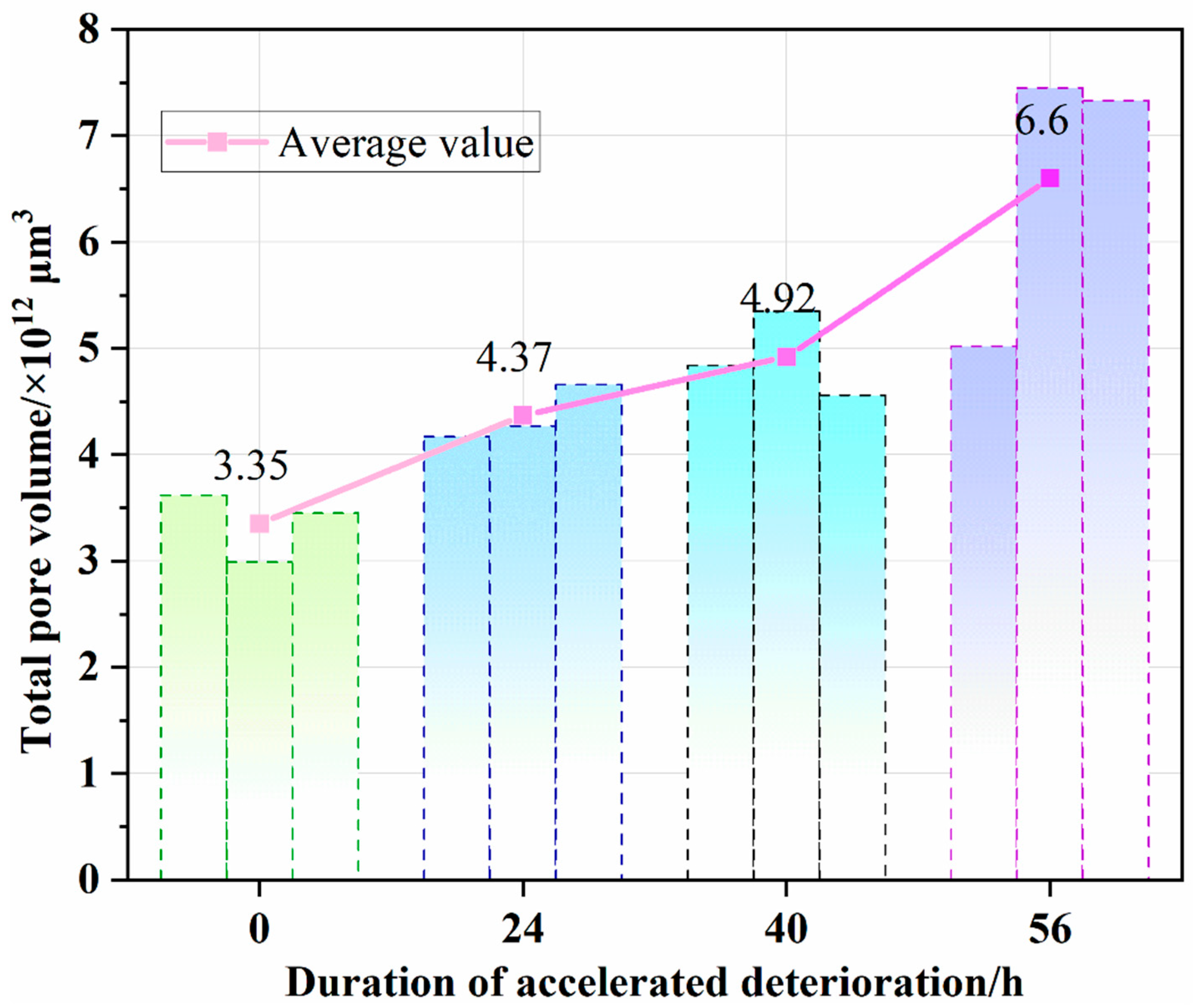

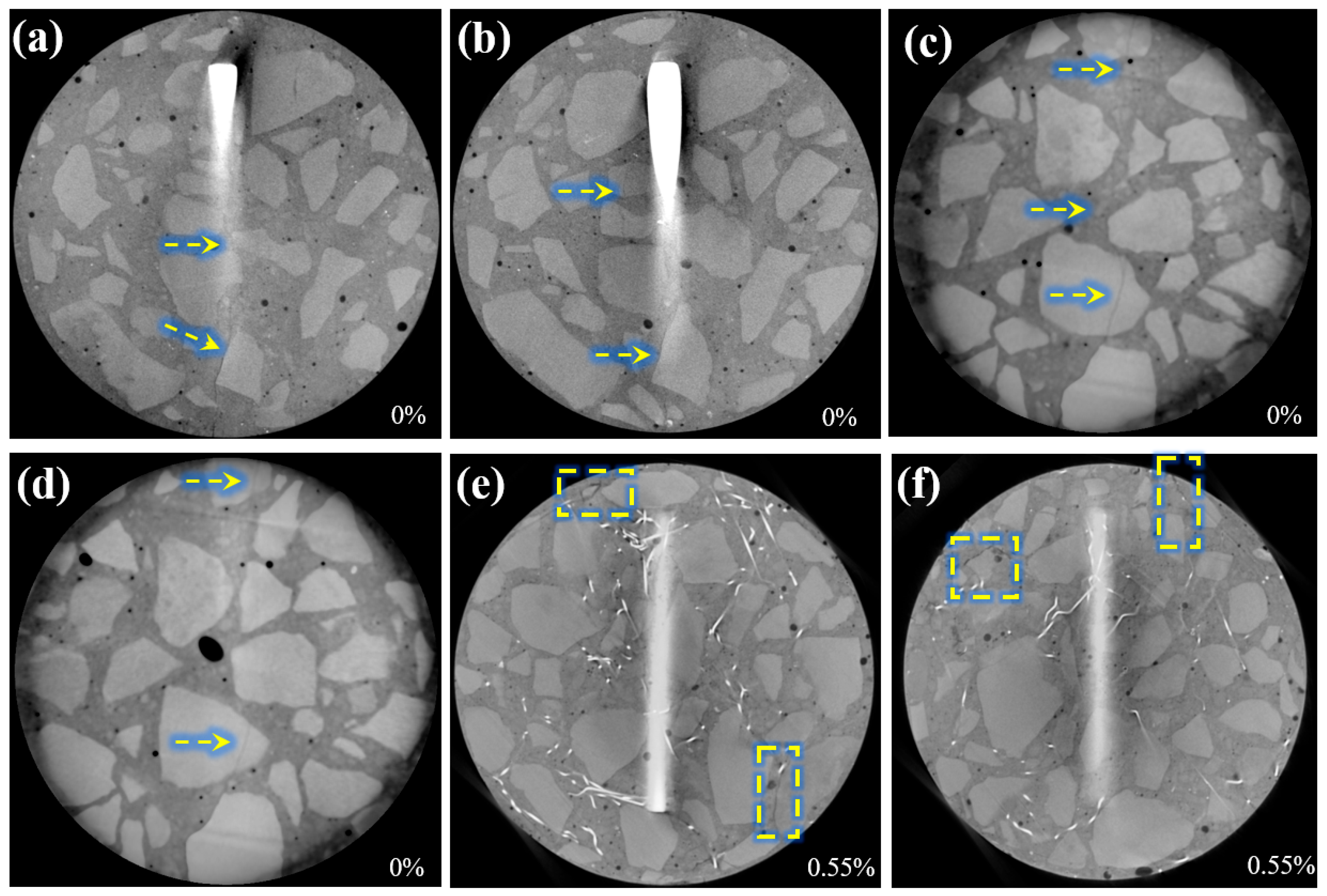

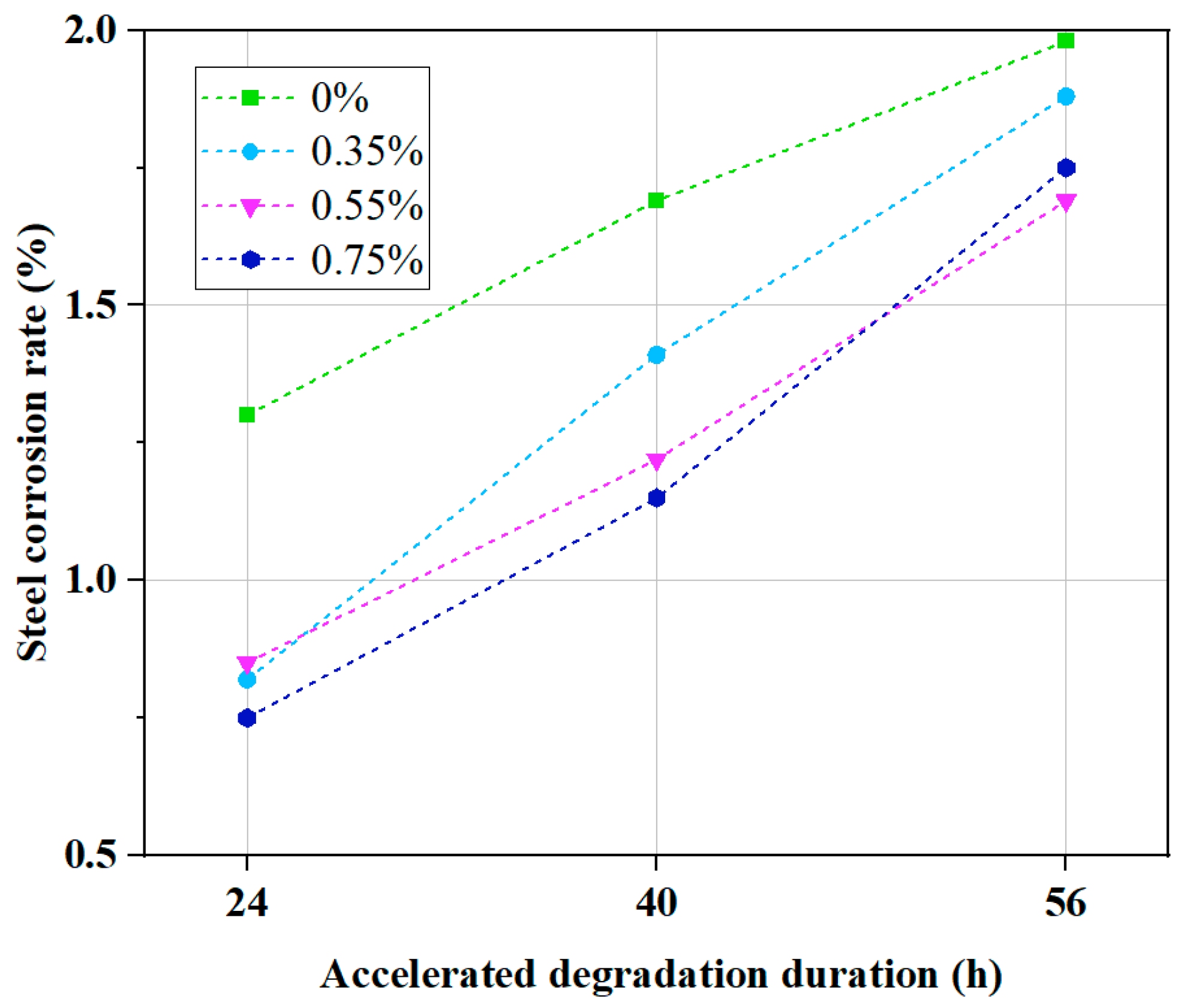
| No. | PC (kg/m3) | PFA (kg/m3) | SP (kg/m3) | SA (kg/m3) | CS (kg/m3) | PC (kg/m3) | W (kg/m3) | SF (%) |
|---|---|---|---|---|---|---|---|---|
| 1 | 305 | 60 | 80 | 734 | 1008 | 6.2 | 158 | 0 |
| 2 | 305 | 60 | 80 | 734 | 1008 | 6.2 | 158 | 0.35 |
| 3 | 305 | 60 | 80 | 734 | 1008 | 6.2 | 158 | 0.55 |
| 4 | 305 | 60 | 80 | 734 | 1008 | 6.2 | 158 | 0.75 |
Disclaimer/Publisher’s Note: The statements, opinions and data contained in all publications are solely those of the individual author(s) and contributor(s) and not of MDPI and/or the editor(s). MDPI and/or the editor(s) disclaim responsibility for any injury to people or property resulting from any ideas, methods, instructions or products referred to in the content. |
© 2025 by the authors. Licensee MDPI, Basel, Switzerland. This article is an open access article distributed under the terms and conditions of the Creative Commons Attribution (CC BY) license (https://creativecommons.org/licenses/by/4.0/).
Share and Cite
Wei, L.; Liu, J.; Shu, H.; Cui, Q.; Peng, W.; Gong, H.; Xue, Y.; Han, M. Degradation Characteristics and Mechanisms of Steel Fiber-Reinforced Concrete Linings in Subsea Tunnels: Insights from Accelerated Erosion Tests with Applied Electric Fields. J. Mar. Sci. Eng. 2025, 13, 670. https://doi.org/10.3390/jmse13040670
Wei L, Liu J, Shu H, Cui Q, Peng W, Gong H, Xue Y, Han M. Degradation Characteristics and Mechanisms of Steel Fiber-Reinforced Concrete Linings in Subsea Tunnels: Insights from Accelerated Erosion Tests with Applied Electric Fields. Journal of Marine Science and Engineering. 2025; 13(4):670. https://doi.org/10.3390/jmse13040670
Chicago/Turabian StyleWei, Longhai, Jiguo Liu, Heng Shu, Qinglong Cui, Wenbo Peng, Huimin Gong, Yiguo Xue, and Min Han. 2025. "Degradation Characteristics and Mechanisms of Steel Fiber-Reinforced Concrete Linings in Subsea Tunnels: Insights from Accelerated Erosion Tests with Applied Electric Fields" Journal of Marine Science and Engineering 13, no. 4: 670. https://doi.org/10.3390/jmse13040670
APA StyleWei, L., Liu, J., Shu, H., Cui, Q., Peng, W., Gong, H., Xue, Y., & Han, M. (2025). Degradation Characteristics and Mechanisms of Steel Fiber-Reinforced Concrete Linings in Subsea Tunnels: Insights from Accelerated Erosion Tests with Applied Electric Fields. Journal of Marine Science and Engineering, 13(4), 670. https://doi.org/10.3390/jmse13040670







